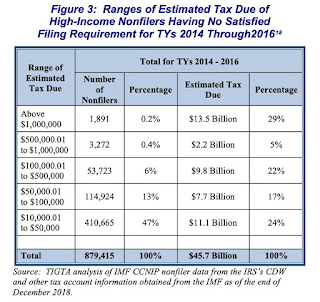On October 19, 2020 we posted TIGTA Lists 10 Most Serious Challenges for IRS for FY 2021, where we discussed that TIGTA, in an Oct. 14 memorandum to Treasury Secretary addressed the 10 most serious management and performance challenges confronting IRS in fiscal year 2021. TIGTA has a statutory requirement to submit an annual report on the subject. Herein we would like to discuss problem #9 INCREASING INTERNATIONAL TAX COMPLIANCE
Complexity and change in the international tax environment require that the IRS collaborate with tax administrations of foreign countries to enforce compliance. The IRS must continue to focus significant efforts on global tax cooperation and tax administration practices that can prevent and resolve disputes among countries to increase certainty for taxpayers.
In most cases, foreign persons are subject to U.S. tax of 30 percent (or lower treaty rate) on their U.S. source income. A foreign individual is any person that is not a U.S. person, including a nonresident alien, a foreign corporation, a foreign partnership, a foreign trust, or a foreign estate. The U.S. tax owed is generally withheld from payments made to foreign persons by a withholding agent. A withholding agent is any U.S. or foreign entity (individual, corporation, partnership, etc.) that takes receipt of, has control or custody of, or disposes of or makes a payment of any income to a foreign individual that is subject to withholding. Withholding agents are required to file Forms 1042-S, Foreign Person’s U.S. Source Income Subject to Withholding, to report on an individual taxpayer basis the income and withholding for each foreign person. For Tax Year 2017, the IRS received 6.3 million Forms 1042-S from 49,618 withholding agents. These agents reported U.S. tax withholdings totaling more than $528 billion.
In response to our prior recommendations, the IRS has implemented processes to improve its identification of reporting discrepancies for Federal tax withheld on U.S. source income paid to foreign individuals. However, these processes did not identify some withholding tax discrepancies. TIGTA reported that IRS processes did not identify 1,919 withholding agents with reporting discrepancies totaling more than $182.7 million.
Our Review Also Identified 366 Withholding Agents That Claimed $506 Million More In Credits For Tax Withheld Than Was Reported On The Forms 1042-S.
In addition, partnerships conducting business in the United States are required to withhold taxes on certain income paid to foreign partners. A foreign partner can be a foreign corporation, foreign partnership, and any other person who is not a U.S. citizen. The withholding serves as an incentive for foreign partners to file the appropriate U.S. tax return. However, TIGTA reported that the IRS’s compliance efforts in this area can be improved. TIGTA identified significant errors in the database that the IRS uses to track withholding reported by partnerships, which limits the IRS’s ability to verify withholding credits and accurately identify potential nonfilers.

Foreign individuals are also required to pay tax related to the sale of U.S. real estate. Specifically, the Foreign Investment in Real Property Tax Act (FIRPTA) of 1980 imposes an income tax on foreign persons selling U.S. real property interests. Buyers are required to withhold a percentage of the anticipated taxes due on the amount realized from the sale. A foreign seller of U.S. property can claim a credit for the tax withheld by the buyer. If the seller’s tax liability is less than the amount of tax withheld, the seller gets a refund of the difference. TIGTA reported that the IRS’s reconciliation processes do not effectively identify and address FIRPTA reporting and payment noncompliance.(TIGTA, Ref. No. 2020-40-014, Millions of Dollars in Discrepancies in Tax Withholding Required by the Foreign Investment in Real Property Tax Act Are Not Being Identified or Addressed (Mar. 2020))
TIGTA Identified 2,988 Buyers With Discrepancies of More
Than $688 Million Between The Withholding Reported
on Forms 8288-A, Statement Of Withholding On Dispositions
By Foreign Persons Of U.S. Real Property Interests,
Filed During Processing Year 2017 And The Withholding Assessed To The Buyer’s Tax Account.
Extensive data inaccuracies in the FIRPTA database, incorrect and unclear guidelines, and employee errors contributed to these discrepancies.
The IRS also has not established processes to use Form 1099-S, Proceeds from Real Estate Transactions, to identify buyers that do not report and pay FIRPTA withholdings.
TIGTA’s Analysis Of Forms 1099-S For Tax Year 2017 Identified Approximately $22 Million In FIRPTA Withholding That Was Not Reported And Paid To The IRS.
Finally, employee errors resulted in 1,835 foreign individuals potentially receiving more than $60 million in FIRPTA withholding credits than they were entitled.
Have an International IRS Tax Problem?
Contact the Tax Lawyers at
Marini & Associates, P.A.
Read more at: Tax Times blog











